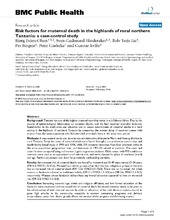| dc.description.abstract | Background Tanzania has one of the highest maternal mortality ratios in sub-Saharan Africa. Due to the paucity of epidemiological information on maternal deaths, and the high maternal mortality estimates found earlier in the study area, our objective was to assess determinants of maternal deaths in a rural setting in the highlands of northern Tanzania by comparing the women dying of maternal causes with women from the same population who had attended antenatal clinics in the same time period. Methods A case-control study was done in two administrative divisions in Mbulu and Hanang districts in rural Tanzania. Forty-five cases of maternal death were found through a comprehensive community- and health-facility based study in 1995 and 1996, while 135 antenatal attendees from four antenatal clinics in the same population, geographical area, and time-span of 1995–96 served as controls. The cases and controls were compared using multivariate logistic regression analyses. Odds ratios, with 95% confidence intervals, were used as an approximation of relative risk, and were adjusted for place of residence (ward) and age. Further adjustment was done for potentially confounding variables. Results An increased risk of maternal deaths was found for women from 35–49 years versus 15–24 years (OR 4.0; 95%CI 1.5–10.6). Women from ethnic groups other than the two indigenous groups of the area had an increased risk of maternal death (OR 13.6; 95%CI 2.5–75.0). There was an increased risk when women or husbands adhered to traditional beliefs, (OR 2.1; 95%CI 1.0–4.5) and (OR 2.6; 95%CI 1.2–5.7), respectively. Women whose husbands did not have any formal education appeared to have an increased risk (OR 2.2; 95%CI 1.0–5.0). Conclusion Increasing maternal age, ethnic and religious affiliation, and low formal education of the husbands were associated with increased risk of maternal death. Increased attention needs to be given to formal education of both men and women. In addition, education of the male decision-makers should be given high priority in the community, especially in matters concerning pregnancy and delivery preparedness, since their choice greatly affects the survival of the pregnant and delivering women. | en_US |
